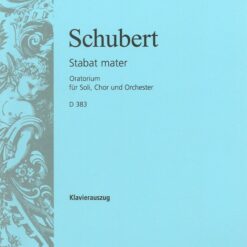-
×
 Schubert, Franz : Stabat mater in F minor D 383
1 × 20,95€
Schubert, Franz : Stabat mater in F minor D 383
1 × 20,95€
Sous-total : 20,95€
 Schubert, Franz : Stabat mater in F minor D 383
Schubert, Franz : Stabat mater in F minor D 383
Sous-total : 20,95€
In Naples, late in the year 1734, Giovanni Battista Pergolesi obtained a commission from a brotherhood of noblemen to write a new setting of the “Stabat mater” Text in order to replace the work of Alessandro Scarlatti, who had passed away in 1725. This work, too, was to be limited to two vocal parts, which reflects the intimate character of this devotional work. Just a few years after its creation, Pergolesi’s “Stabat mater” setting became known throughout the entire musical world, regardless of all religious boundaries. No other musical work was printed and copied more often in the 18th century than the “Stabat mater. ” The present edition is based on the autograph, which contains corrections and deletions. It seems to have been hastily transcribed from sketches intended for the copyist’s use. The publisher thus faced a particularly challenging task here. « Besten Dank für die Bereitstellung von Notenmaterial auf dem letzten Stand für gerade dieses hervorragende Meisterwerk! » (Singende Kirche) « Breitkopf stellt zu seiner Ausgabe des Stabat-Maters eine Taschenpartitur zur Verfügung – eine nach den Quellen sorgfältig erstellte, vorbildliche Ausgabe in übersichtlichem Druck und ausfühlichem Vorw Ort. » (Württembergische Blätter für Kirchenmusik)
| Poids | 186 g |
|---|---|
| Dimensions | 19 × 27 cm |
| Compositeur | Giovanni Battista, Pergolesi |
| Éditeur | Breitkopf & Härtel |
| ISMN | 9790004176382 |
| Référence éditeur | EB 8330 |
| Prix Editeur | 13, 20 € |
| Parties | solos: SA – choir: SA(ad lib) – org – str |
| Image de la partition | https://www.breitkopf.com/assets/haendler/samples/9790004176382.pdf |
| Cookie | Durée | Description |
|---|---|---|
| cookielawinfo-checkbox-analytics | 11 months | This cookie is set by GDPR Cookie Consent plugin. The cookie is used to store the user consent for the cookies in the category "Analytics". |
| cookielawinfo-checkbox-functional | 11 months | The cookie is set by GDPR cookie consent to record the user consent for the cookies in the category "Functional". |
| cookielawinfo-checkbox-necessary | 11 months | This cookie is set by GDPR Cookie Consent plugin. The cookies is used to store the user consent for the cookies in the category "Necessary". |
| cookielawinfo-checkbox-others | 11 months | This cookie is set by GDPR Cookie Consent plugin. The cookie is used to store the user consent for the cookies in the category "Other. |
| cookielawinfo-checkbox-performance | 11 months | This cookie is set by GDPR Cookie Consent plugin. The cookie is used to store the user consent for the cookies in the category "Performance". |
| viewed_cookie_policy | 11 months | The cookie is set by the GDPR Cookie Consent plugin and is used to store whether or not user has consented to the use of cookies. It does not store any personal data. |
Avis
Il n’y a encore aucun avis